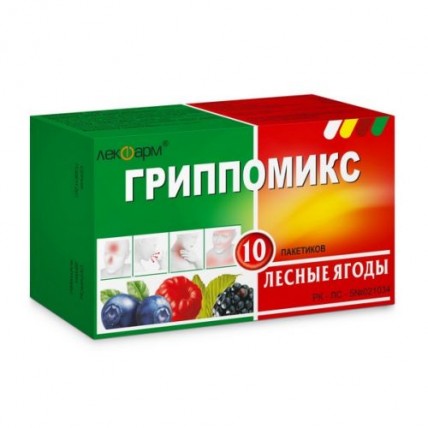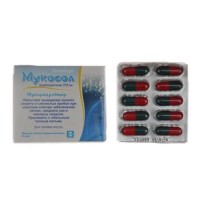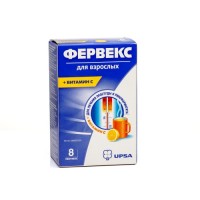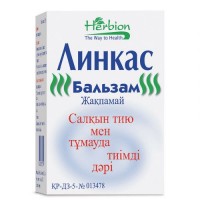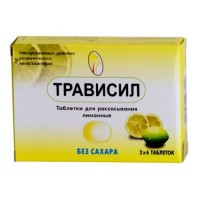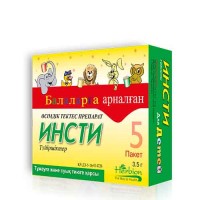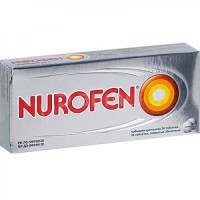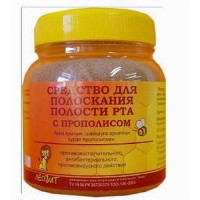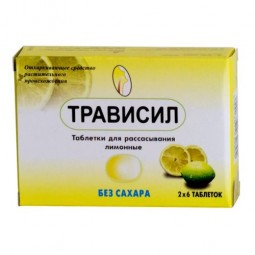Grippomiks with taste of wild berries 10s powder for solution
- $17.40
Sku:
0c756db9504e
Brand:
Lekpharm (Belarus)
Grippomix
the International unlicensed name
Is not present
the Dosage form
Powder for preparation of oral solution (wild berries, orange, a lemon).
The structure
contains One bag:
active agents: paracetamol of 360.0 mg, Rimantadinum a hydrochloride of 75.0 mg, ascorbic acid of 125.0 mg, a tsetirizina dihydrochloride of 2.5 mg, calcium a carbonate 70 with sorbitol (in terms of calcium) 89.3 mg (25.0 mg),
excipients: aspartame (E 951), anhydrous citric acid, fragrance (Wild berries or Orange or Lemon), sugar.
The description
Powder of white or almost white color with a yellowish or pinkish shade with a smell of wild berries. Existence of soft lumps is allowed.
Drug solution - transparent or opalescent from colourless till yellowish or pinkish color with a smell of wild berries. Existence of an insignificant deposit is allowed (for Grippomix wild berries).
Powder of white or almost white color with a yellowish or gray shade with an orange smell. Existence of soft lumps is allowed.
Drug solution - transparent or opalescent from colourless till yellowish color with an orange smell. Existence of an insignificant deposit is allowed (for Grippomix orange).
Powder of white or almost white color with a yellowish or gray shade with a lemon smell. Existence of soft lumps is allowed.
Drug solution - transparent or opalescent from colourless till yellowish color with a lemon smell. Existence of an insignificant deposit is allowed (for Grippomix a lemon).
Pharmacotherapeutic group
Analgetics-antipyretics others. Anilides. Paracetamol in a combination with other drugs (excepting psikholeptik).
The ATX N02BE51 code
the Pharmacological
Pharmacokinetics Paracetamol properties is quickly and completely soaked up from digestive tract, evenly distributed in fabrics. Bioavailability of paracetamol about 90%. Extent of binding by proteins — 25–50%. T1/2 makes 2–4 hours. Paracetamol in a liver up to 80–90% where it is conjugated with glucuronic or sulphuric acid is metabolized and then removed with urine within the first day. About 3% of paracetamol are allocated in not changed look.
Rimantadinum the hydrochloride after intake slowly, is almost completely absorbed in intestines. Linking with proteins of plasma - about 40%. Cmax at reception of 100 mg of 1 times / – 181 ng/ml, on 100 mg 2 - 416 ng/ml. It is metabolized in a liver. T1/2 - 24-36 h. In chronic kidney disease of T1/2 increases twice. It is removed through kidneys. At persons with a renal failure and at elderly people can collect in toxic concentration if the dose does not korrigirutsya in proportion to reduction of clearance of creatinine.
Tsetirizina dihydrochloride is quickly soaked up from digestive tract, absorption reaches 70%, substantially communicates proteins of blood plasma. T1/2 - about 10 hours at adults, at children is from 6 to 12 years - about 6 hours. In a renal failure the general clearance of drug decreases. Tsetirizin is practically not metabolized in a liver. Two thirds of the accepted dose are removed in not changed view with urine.
Ascorbic acid after intake is completely absorbed from a GIT. It is widely distributed in body tissues. Concentration of ascorbic acid in blood plasma normal makes about 10-20 mkg/ml. Linking with proteins of blood plasma makes about 25%. It is metabolized in a liver, removed with urine in the form of oxalate and in not changed look. The ascorbic acid accepted in excessive quantities quickly is removed in not changed view with urine.
Calcium the carbonate after oral administration is absorbed in proximal department of a small intestine, at the same time absorption of calcium ions happens to the help of D-vitaminzavisimykh of transport mechanisms. In blood plasma calcium contacts proteins of plasma, some part of calcium is in freedom to the ionized form. Calcium is removed through intestines, kidneys and sweat glands. Renal removal depends on glomerular filtration and a canalicular reabsorption of calcium.
The pharmacodynamics
Pharmacological activity of medicine is caused by complex action of its components - paracetamol, Rimantadinum of a hydrochloride, ascorbic acid, a tsetirizin of dihydrochloride and calcium of a carbonate.
Medicine renders the antiviral, interferonogenny, febrifugal, anti-inflammatory, anesthetizing, antihistaminic, angioprotektorny action.
Paracetamol possesses febrifugal, analgeziruyushchy and some anti-inflammatory action, reduces the pain syndrome which is observed in catarrhal diseases, a sore throat, a headache, muscular and articulate pain, reduces high temperature. Blocks cyclooxygenase of the first and second types mainly in the central nervous system. Due to the lack of the blocking influence on synthesis of prostaglandins in peripheral fabrics, does not influence water salt metabolism (Na delay + and waters) and a mucous membrane of digestive tract.
Rimantadinum a hydrochloride - the antiviral means derivative of an adamantan. It is active concerning various influenza strains And, the Herpes simplex viruses of type I and II, viruses of tick-borne encephalitis (Central European and Russian spring and summer of group of an arbovirus this. Flaviviridae).
Rimantadinum renders the inhibiting effect at an early stage of a replikativny cycle, perhaps inhibits a transcription of a virus genome. Results of genetic researches allow to assume that virus protein of the specified gene of M2 of virion plays an important role in susceptibility of an influenza virus And to Rimantadinum. Rimantadinum inhibits replication in the cellular culture of isolates of each of three antigenic subtypes of an influenza virus And, i.e. H1N1, H2N2 and H3N3 allocated from cells of the person. Rimantadinum is inactive or almost inactive concerning an influenza virus of Century. Quantitative ratio between susceptibility in the cellular culture of an influenza virus And to Rimantadinum and clinical effect is not established. The results of tests of sensitivity expressed as the concentration of medicinal substance necessary for inhibition of replication of a virus for 50% or more in cellular culture, strongly differ (from 19 nanometers to 93 microns) depending on the used test report, the size of inoculum, the isolated strains of influenza viruses And yes used like cells. RESISTANCE: in cellular culture and in vivo isolates of an influenza virus, resistant to Rimantadinum, And, arisen as a result of treatment were emitted. Rimantadinum-resistant influenza strains And appeared among recently allocated strains in experimental conditions where Rimantadinum was used. It was shown that resistant viruses can be transmitted and are a cause of illness typical flu. Replacement of any of five amino acids in a membrane of domain M2 results in resistance of Rimantadinum. The most widespread replacements causing resistance include flu A (H1N1) and A (H3N2) and S31N. Other, less widespread replacements causing resistance include A30F, V27A and L26F.
The resistance to Rimantadinum is found in the isolated strains of pandemic seasonal flu in the persons who were not receiving Rimantadinum. It was shown that viruses of swine flu And (H1N1) (S-OIV) which were rezistentna to Rimantadinum contain S31N replacement. CROSS-RESISTANCE: the cross-resistance among adamantan, Rimantadinum and an amantadin is observed. The resistance to Rimantadinum arises through cross-resistance to an amantadin and vice versa. Replacements of amino acids which are the resistance reason to Rimantadinum include (most often) M2 S31N and also less widespread changes of V27,V30A, L26F and A30T.
Ascorbic acid participates in regulation of oxidation-reduction processes, carbohydrate metabolism, blood clotting, angenesis, reduces vascular permeability. Has the antiagregantny and significant antioxidant properties. Maintains colloidal state of intercellular substance and normal permeability of capillaries (oppresses hyaluronidase). Due to activation of respiratory enzymes in a liver strengthens its disintoxication and belkovoobrazovatelny functions, increases synthesis of a prothrombin. Regulates immunological reactions (activates synthesis of antibodies, C3 component of a complement, interferon), promotes phagocytosis, increases body resistance to infections. Slows down release and accelerates degradation of a histamine, formation of prostaglandins and other mediators of inflammation and allergic reactions oppresses.
Tsetirizina dihydrochloride - a blocker of peripheral histamine H1 receptors, antihistaminic antiallergic means, Hydroxyzinum metabolite. In pharmacological active doses has no significant sedation. Brakes a gistaminoposredovanny early phase of allergic reaction, prevents various physiological and pathophysiological effects of a histamine, such as expansion and hyperpermeability of capillaries (edematization, small tortoiseshells, reddening), stimulation of sensitive nerve terminations (itching, pain) and reduction of unstriated muscles of respiratory organs and digestive tract. At a late stage of allergic reaction of a tsetirizin dihydrochloride inhibits discharge of a histamine and migration of eosinophils and other cells, weakening thus late allergic reaction. Reduces an expression of molecules of adhesion, such as ICAM-1 and VCAM-1 which are markers of allergic inflammation. Action of other mediators and inductors of secretion of a histamine, such as PAF (platelet activating factor) and substance P suppresses. Considerably lowers the hyperreactivity of a bronchial tree arising in response to release of a histamine at patients with bronchial asthma. These effects are not followed by the central action.
Calcium the carbonate prevents development of hyperpermeability and fragility of vessels, promotes normal blood clotting, participates in implementation of processes of transfer of nervous impulses, reductions of skeletal and smooth muscles, in regulation of warm activity.
Indications
- symptomatic treatment of flu, SARS (acute respiratory viral infections), feverish states owing to virus damage of airways at adults and children are more senior than 12 years
the Route of administration and doses
Inside. Contents of a bag are dissolved in 1 glass of boiled hot water. Use hot.
To adults and children 12 years are more senior - on 1 powder 3 times a day at preservation of a feverish syndrome within 3-5 days.
In the absence of improvement of health during intake of medicine, treatment it is necessary to stop and see a doctor!
Side effects
determined the frequency of undesirable reactions Provided below, using the following note: very often (& gt, 1/10), it is frequent (& gt, 1/100 - & lt, 1/10), infrequently (& gt, 1/1.000 - & lt, 1/100), is rare (& gt, 1/10.000 - & lt, 1/1.000), is very rare (& lt, 1/10.000), it is unknown (it is impossible to define on the basis of the available data.
From the central nervous system: seldom – a headache, increased fatigue, hyperexcitability, dizziness, a tremor, a hyperkinesia.
From digestive tract: lasting reception more than 7 days are possible injuries of a mucous membrane of a stomach and a dvenadtsatitiperstny gut, dyspepsia, dryness in a mouth, nausea, anorexia, a meteorism, diarrhea.
From the system of blood: lasting reception more than 7 days - an agranulocytosis, a leukopenia, thrombocytopenia, a neutropenia, anemia.
Allergic reactions: seldom - skin rash, an itching, a small tortoiseshell are possible.
Contraindications
- hypersensitivity to drug components
- digestive tract erosive cankers in an aggravation phase
- gastrointestinal bleedings
- hemophilia
- hemorrhagic diathesis
- a prothrombinopenia
- a renal failure
- acute diseases of kidneys (acute glomerulonephritis, acute pyelonephritis)
- acute diseases of a liver (acute hepatitis)
- portal hypertensia
- pregnancy and the period of a lactation
- children's age up to 12 years
- a thyrotoxicosis
- an alcoholism
Medicinal interactions
In need of joint reception with other medicines previously consult with the doctor.
Combined use of paracetamol and Rimantadinum leads to decrease in the maximum concentration and AUC Rimantadinum approximately for 11%.
Ascorbic acid lowers Rimantadinum Cmax by 10%. Cimetidinum reduces clearance of Rimantadinum by 18%.
Rimantadinum reduces efficiency of antiepileptic means.
Paracetamol reduces efficiency of uricosuric medicines. Inductors of microsomal oxidation in a liver (Phenytoinum, ethanol, barbiturates, rifampicin, phenylbutazone, tricyclic antidepressants), ethanol and hepatotoxic drugs increase products of hydroxylated active metabolites that causes a possibility of development of heavy intoxications even at small overdose. Long use of barbiturates reduces efficiency of paracetamol. Ethanol contributes to the development of acute pancreatitis. Inhibitors of microsomal oxidation (including, Cimetidinum) reduce risk of hepatotoxic action. Long sharing of medicine and other non-steroidal anti-inflammatory drugs increases risk of development of a 'analgetic' nephropathy and renal papillary necrosis, approach of an end-stage of a renal failure. Diflunisal increases plasma concentration of paracetamol by 50% - risk of development of hepatotoxicity. Myelotoxic medicines strengthen manifestations of a gematotoksichnost of medicine.
Ascorbic acid increases concentration in blood of benzylpenicillin and tetracyclines, in a dose of 1 g/days increases bioavailability of ethinylestradiol (including being a part of oral contraceptives). Reduces efficiency of heparin and indirect anticoagulants. Increases risk of development of a crystalluria at treatment by salicylates and streptocides of short action, slows down removal by kidneys of acids, increases removal of the medicines having alkali reaction (including alkaloids). Increases the general clearance of ethanol which in turn reduces concentration of ascorbic acid in an organism. At simultaneous use reduces chronotropic action of an izoprenalin. Barbiturates and Primidonum increase removal of ascorbic acid with urine. Reduces therapeutic action of neuroleptics - derivatives of a fenotiazin, a canalicular reasorbtion of amphetamine and tricyclic antidepressants.
At co-administration of medicine with theophylline (especially if doses of theophylline exceed 400 mg) the increase in concentration in serum and relative overdose of a tsetirizin because of reduced clearance can be observed.
Myelotoxic medicines strengthen manifestations of a gematotoksichnost of a tsetirizin.
It is necessary to observe extra care at combined use of medicine with hypnotic drugs and sedatives, alcohol.
The special
instructions Medicine it is not intended for prevention.
Treatment should be begun no later than 48 h from emergence of the first symptoms of a disease.
Use duration - no more than 5 days. At prolonged use (over 7 days) the exacerbation of chronic associated diseases is possible, at elderly patients with arterial hypertension the risk of developing a hemorrhagic stroke increases (at the expense of Rimantadinum medicine which is a part).
For forming of postinfectious immunity children are not recommended to apply to treatment up to 12 years.
At instructions in the anamnesis on epilepsy and the carried-out anticonvulsant therapy against the background of use of Rimantadinum the risk of developing an epileptic seizure increases.
At reception the risk of development of injuries of a liver at patients with an alcoholic hepatosis increases.
Distorts indicators of laboratory researches at quantitative definition of glucose and uric acid in plasma (paracetamol).
Due to the promoting effect of ascorbic acid on synthesis of corticosteroid hormones it is necessary to monitor function of adrenal glands and arterial blood pressure. Ascorbic acid as reducer can distort results of various laboratory tests (content in blood of glucose, bilirubin, activity of 'hepatic' transaminases and a lactate dehydrogenase).
Not to apply in the presence of the metastasizing tumors.
In order to avoid the possible damaging action on a liver and also in connection with increase in risk of gastrointestinal bleeding, during administration of drug it is not necessary to take alcohol.
With care apply at patients with rare hereditary diseases of intolerance of fructose, a sprue of a glucose/galactose or insufficiency of invertase - isomaltases.
With care apply at patients with phenylketonuria since the aspartame which is a phenylalanine source is a part of drug.
Pregnancy and lactation
Teratogenic effects: Pregnancy – category C. Pregnant women have no adequate and controlled researches. Rimantadinum as it is reported, gets through a placenta at mice. Rimantadinum embriotoksichen at rats at introduction in a dose of 200 mg/kg/days (11 times of MRHD on the basis of mg/sq.m). At this dose the embriotoksichesky action consisted in increase in a fetal resorption at rats, this dose also caused a set of maternal effects, including an ataxy, a tremor, spasms and considerable weight reduction. Embriotoxity when rabbits received a dose to 50 mg/kg/days (approximately by 0.1 times of MRHD it is based on AUC) was not observed, but proofs in the form of anomaly of development were noted in the form of change of a ratio of fruits with 12 or 13 edges. This ratio, as a rule, about 50:50 in a dung, but after treatment by Rimantadinum 80:20.
Not teratogenic effects: Rimantadinum was entered to pregnant rats in peri- and a puerperal period in doses of 30, 60 and 120 mg/kg/days (1,7, 3,4 and 6.8 times of MRHD on the basis of mg/sq.m). The maternal toxicity during pregnancy was noted on two higher doses of Rimantadinum, and in the maximum dose of 120 mg/kg/days, there was an increase in mortality in the first 2-4 days after the delivery. Decrease in fertility of generation of F1 was also noted for two higher doses.
For these reasons drug is contraindicated at pregnancy.
Lactation period: Rimantadinum is contraindicated to nursing mothers because of the side effects noted at posterity of the rats receiving Rimantadinum during the feeding period. Rimantadinum was found in milk of rats depending on a dose: from 2 to 3 hours after reception.
Features of influence of medicine on ability to run vehicles or potentially dangerous mechanisms.
During treatment it is necessary to be careful during the driving of motor transport and occupation other potentially dangerous types of activity demanding the increased concentration of attention and speed of psychomotor reactions (contains Rimantadinum).
Overdose
Symptoms: in the first the 24th h are possible pallor, nausea, vomiting and pain in epigastric area, a tremor, drowsiness, tachycardia, increase in bilirubin in blood, disbolism, exacerbation of the accompanying chronic diseases.
Signs of overdose of paracetamol - nausea, vomiting, stomach aches, pallor of integuments, anorexia. In a day or two are defined signs of damage of a liver. In hard cases the liver failure and coma develops. Toxic effect of paracetamol at adults perhaps after reception over 10-15 g of paracetamol: increase in activity of hepatic transaminases, increase in a prothrombin time (in 12-48 h after reception), the developed clinical picture of damage of a liver appears in 1-6 days. Seldom damage of a liver develops immediately and can be complicated by a renal failure (tubular necrosis).
Treatment: At suspicion on overdose it is necessary to see a doctor immediately. The victim should make gastric lavage within the first 4 hours of poisoning, to accept adsorbents (activated carbon). Introduction of donators of SH-group and predecessors of synthesis of glutathione – methionine – in 8 – 9 hours after overdose and N-Acetylcysteinum – in 12 hours. Need for holding additional therapeutic actions is defined depending on concentration of paracetamol in blood and also from time which passed after its reception.
A form of release and packing
On 10 g of powder in the bag from the combined material (a film polietilentereftalatny, a film polypropylene white, a foil, a film polyethylene transparent) soldered from four parties.
On five, ten or fifteen bags together with the instruction for medical use in the state and Russian languages place in a pack from cardboard.
To Store storage conditions in the dry place protected from light, at a temperature not above 25 °C.
To store out of children's reach!
2 years
not to use a period of storage after the expiration date specified on packing.
Prescription status
According to the prescription
the Develop Producer SOOO Lekfarm
the International unlicensed name
Is not present
the Dosage form
Powder for preparation of oral solution (wild berries, orange, a lemon).
The structure
contains One bag:
active agents: paracetamol of 360.0 mg, Rimantadinum a hydrochloride of 75.0 mg, ascorbic acid of 125.0 mg, a tsetirizina dihydrochloride of 2.5 mg, calcium a carbonate 70 with sorbitol (in terms of calcium) 89.3 mg (25.0 mg),
excipients: aspartame (E 951), anhydrous citric acid, fragrance (Wild berries or Orange or Lemon), sugar.
The description
Powder of white or almost white color with a yellowish or pinkish shade with a smell of wild berries. Existence of soft lumps is allowed.
Drug solution - transparent or opalescent from colourless till yellowish or pinkish color with a smell of wild berries. Existence of an insignificant deposit is allowed (for Grippomix wild berries).
Powder of white or almost white color with a yellowish or gray shade with an orange smell. Existence of soft lumps is allowed.
Drug solution - transparent or opalescent from colourless till yellowish color with an orange smell. Existence of an insignificant deposit is allowed (for Grippomix orange).
Powder of white or almost white color with a yellowish or gray shade with a lemon smell. Existence of soft lumps is allowed.
Drug solution - transparent or opalescent from colourless till yellowish color with a lemon smell. Existence of an insignificant deposit is allowed (for Grippomix a lemon).
Pharmacotherapeutic group
Analgetics-antipyretics others. Anilides. Paracetamol in a combination with other drugs (excepting psikholeptik).
The ATX N02BE51 code
the Pharmacological
Pharmacokinetics Paracetamol properties is quickly and completely soaked up from digestive tract, evenly distributed in fabrics. Bioavailability of paracetamol about 90%. Extent of binding by proteins — 25–50%. T1/2 makes 2–4 hours. Paracetamol in a liver up to 80–90% where it is conjugated with glucuronic or sulphuric acid is metabolized and then removed with urine within the first day. About 3% of paracetamol are allocated in not changed look.
Rimantadinum the hydrochloride after intake slowly, is almost completely absorbed in intestines. Linking with proteins of plasma - about 40%. Cmax at reception of 100 mg of 1 times / – 181 ng/ml, on 100 mg 2 - 416 ng/ml. It is metabolized in a liver. T1/2 - 24-36 h. In chronic kidney disease of T1/2 increases twice. It is removed through kidneys. At persons with a renal failure and at elderly people can collect in toxic concentration if the dose does not korrigirutsya in proportion to reduction of clearance of creatinine.
Tsetirizina dihydrochloride is quickly soaked up from digestive tract, absorption reaches 70%, substantially communicates proteins of blood plasma. T1/2 - about 10 hours at adults, at children is from 6 to 12 years - about 6 hours. In a renal failure the general clearance of drug decreases. Tsetirizin is practically not metabolized in a liver. Two thirds of the accepted dose are removed in not changed view with urine.
Ascorbic acid after intake is completely absorbed from a GIT. It is widely distributed in body tissues. Concentration of ascorbic acid in blood plasma normal makes about 10-20 mkg/ml. Linking with proteins of blood plasma makes about 25%. It is metabolized in a liver, removed with urine in the form of oxalate and in not changed look. The ascorbic acid accepted in excessive quantities quickly is removed in not changed view with urine.
Calcium the carbonate after oral administration is absorbed in proximal department of a small intestine, at the same time absorption of calcium ions happens to the help of D-vitaminzavisimykh of transport mechanisms. In blood plasma calcium contacts proteins of plasma, some part of calcium is in freedom to the ionized form. Calcium is removed through intestines, kidneys and sweat glands. Renal removal depends on glomerular filtration and a canalicular reabsorption of calcium.
The pharmacodynamics
Pharmacological activity of medicine is caused by complex action of its components - paracetamol, Rimantadinum of a hydrochloride, ascorbic acid, a tsetirizin of dihydrochloride and calcium of a carbonate.
Medicine renders the antiviral, interferonogenny, febrifugal, anti-inflammatory, anesthetizing, antihistaminic, angioprotektorny action.
Paracetamol possesses febrifugal, analgeziruyushchy and some anti-inflammatory action, reduces the pain syndrome which is observed in catarrhal diseases, a sore throat, a headache, muscular and articulate pain, reduces high temperature. Blocks cyclooxygenase of the first and second types mainly in the central nervous system. Due to the lack of the blocking influence on synthesis of prostaglandins in peripheral fabrics, does not influence water salt metabolism (Na delay + and waters) and a mucous membrane of digestive tract.
Rimantadinum a hydrochloride - the antiviral means derivative of an adamantan. It is active concerning various influenza strains And, the Herpes simplex viruses of type I and II, viruses of tick-borne encephalitis (Central European and Russian spring and summer of group of an arbovirus this. Flaviviridae).
Rimantadinum renders the inhibiting effect at an early stage of a replikativny cycle, perhaps inhibits a transcription of a virus genome. Results of genetic researches allow to assume that virus protein of the specified gene of M2 of virion plays an important role in susceptibility of an influenza virus And to Rimantadinum. Rimantadinum inhibits replication in the cellular culture of isolates of each of three antigenic subtypes of an influenza virus And, i.e. H1N1, H2N2 and H3N3 allocated from cells of the person. Rimantadinum is inactive or almost inactive concerning an influenza virus of Century. Quantitative ratio between susceptibility in the cellular culture of an influenza virus And to Rimantadinum and clinical effect is not established. The results of tests of sensitivity expressed as the concentration of medicinal substance necessary for inhibition of replication of a virus for 50% or more in cellular culture, strongly differ (from 19 nanometers to 93 microns) depending on the used test report, the size of inoculum, the isolated strains of influenza viruses And yes used like cells. RESISTANCE: in cellular culture and in vivo isolates of an influenza virus, resistant to Rimantadinum, And, arisen as a result of treatment were emitted. Rimantadinum-resistant influenza strains And appeared among recently allocated strains in experimental conditions where Rimantadinum was used. It was shown that resistant viruses can be transmitted and are a cause of illness typical flu. Replacement of any of five amino acids in a membrane of domain M2 results in resistance of Rimantadinum. The most widespread replacements causing resistance include flu A (H1N1) and A (H3N2) and S31N. Other, less widespread replacements causing resistance include A30F, V27A and L26F.
The resistance to Rimantadinum is found in the isolated strains of pandemic seasonal flu in the persons who were not receiving Rimantadinum. It was shown that viruses of swine flu And (H1N1) (S-OIV) which were rezistentna to Rimantadinum contain S31N replacement. CROSS-RESISTANCE: the cross-resistance among adamantan, Rimantadinum and an amantadin is observed. The resistance to Rimantadinum arises through cross-resistance to an amantadin and vice versa. Replacements of amino acids which are the resistance reason to Rimantadinum include (most often) M2 S31N and also less widespread changes of V27,V30A, L26F and A30T.
Ascorbic acid participates in regulation of oxidation-reduction processes, carbohydrate metabolism, blood clotting, angenesis, reduces vascular permeability. Has the antiagregantny and significant antioxidant properties. Maintains colloidal state of intercellular substance and normal permeability of capillaries (oppresses hyaluronidase). Due to activation of respiratory enzymes in a liver strengthens its disintoxication and belkovoobrazovatelny functions, increases synthesis of a prothrombin. Regulates immunological reactions (activates synthesis of antibodies, C3 component of a complement, interferon), promotes phagocytosis, increases body resistance to infections. Slows down release and accelerates degradation of a histamine, formation of prostaglandins and other mediators of inflammation and allergic reactions oppresses.
Tsetirizina dihydrochloride - a blocker of peripheral histamine H1 receptors, antihistaminic antiallergic means, Hydroxyzinum metabolite. In pharmacological active doses has no significant sedation. Brakes a gistaminoposredovanny early phase of allergic reaction, prevents various physiological and pathophysiological effects of a histamine, such as expansion and hyperpermeability of capillaries (edematization, small tortoiseshells, reddening), stimulation of sensitive nerve terminations (itching, pain) and reduction of unstriated muscles of respiratory organs and digestive tract. At a late stage of allergic reaction of a tsetirizin dihydrochloride inhibits discharge of a histamine and migration of eosinophils and other cells, weakening thus late allergic reaction. Reduces an expression of molecules of adhesion, such as ICAM-1 and VCAM-1 which are markers of allergic inflammation. Action of other mediators and inductors of secretion of a histamine, such as PAF (platelet activating factor) and substance P suppresses. Considerably lowers the hyperreactivity of a bronchial tree arising in response to release of a histamine at patients with bronchial asthma. These effects are not followed by the central action.
Calcium the carbonate prevents development of hyperpermeability and fragility of vessels, promotes normal blood clotting, participates in implementation of processes of transfer of nervous impulses, reductions of skeletal and smooth muscles, in regulation of warm activity.
Indications
- symptomatic treatment of flu, SARS (acute respiratory viral infections), feverish states owing to virus damage of airways at adults and children are more senior than 12 years
the Route of administration and doses
Inside. Contents of a bag are dissolved in 1 glass of boiled hot water. Use hot.
To adults and children 12 years are more senior - on 1 powder 3 times a day at preservation of a feverish syndrome within 3-5 days.
In the absence of improvement of health during intake of medicine, treatment it is necessary to stop and see a doctor!
Side effects
determined the frequency of undesirable reactions Provided below, using the following note: very often (& gt, 1/10), it is frequent (& gt, 1/100 - & lt, 1/10), infrequently (& gt, 1/1.000 - & lt, 1/100), is rare (& gt, 1/10.000 - & lt, 1/1.000), is very rare (& lt, 1/10.000), it is unknown (it is impossible to define on the basis of the available data.
From the central nervous system: seldom – a headache, increased fatigue, hyperexcitability, dizziness, a tremor, a hyperkinesia.
From digestive tract: lasting reception more than 7 days are possible injuries of a mucous membrane of a stomach and a dvenadtsatitiperstny gut, dyspepsia, dryness in a mouth, nausea, anorexia, a meteorism, diarrhea.
From the system of blood: lasting reception more than 7 days - an agranulocytosis, a leukopenia, thrombocytopenia, a neutropenia, anemia.
Allergic reactions: seldom - skin rash, an itching, a small tortoiseshell are possible.
Contraindications
- hypersensitivity to drug components
- digestive tract erosive cankers in an aggravation phase
- gastrointestinal bleedings
- hemophilia
- hemorrhagic diathesis
- a prothrombinopenia
- a renal failure
- acute diseases of kidneys (acute glomerulonephritis, acute pyelonephritis)
- acute diseases of a liver (acute hepatitis)
- portal hypertensia
- pregnancy and the period of a lactation
- children's age up to 12 years
- a thyrotoxicosis
- an alcoholism
Medicinal interactions
In need of joint reception with other medicines previously consult with the doctor.
Combined use of paracetamol and Rimantadinum leads to decrease in the maximum concentration and AUC Rimantadinum approximately for 11%.
Ascorbic acid lowers Rimantadinum Cmax by 10%. Cimetidinum reduces clearance of Rimantadinum by 18%.
Rimantadinum reduces efficiency of antiepileptic means.
Paracetamol reduces efficiency of uricosuric medicines. Inductors of microsomal oxidation in a liver (Phenytoinum, ethanol, barbiturates, rifampicin, phenylbutazone, tricyclic antidepressants), ethanol and hepatotoxic drugs increase products of hydroxylated active metabolites that causes a possibility of development of heavy intoxications even at small overdose. Long use of barbiturates reduces efficiency of paracetamol. Ethanol contributes to the development of acute pancreatitis. Inhibitors of microsomal oxidation (including, Cimetidinum) reduce risk of hepatotoxic action. Long sharing of medicine and other non-steroidal anti-inflammatory drugs increases risk of development of a 'analgetic' nephropathy and renal papillary necrosis, approach of an end-stage of a renal failure. Diflunisal increases plasma concentration of paracetamol by 50% - risk of development of hepatotoxicity. Myelotoxic medicines strengthen manifestations of a gematotoksichnost of medicine.
Ascorbic acid increases concentration in blood of benzylpenicillin and tetracyclines, in a dose of 1 g/days increases bioavailability of ethinylestradiol (including being a part of oral contraceptives). Reduces efficiency of heparin and indirect anticoagulants. Increases risk of development of a crystalluria at treatment by salicylates and streptocides of short action, slows down removal by kidneys of acids, increases removal of the medicines having alkali reaction (including alkaloids). Increases the general clearance of ethanol which in turn reduces concentration of ascorbic acid in an organism. At simultaneous use reduces chronotropic action of an izoprenalin. Barbiturates and Primidonum increase removal of ascorbic acid with urine. Reduces therapeutic action of neuroleptics - derivatives of a fenotiazin, a canalicular reasorbtion of amphetamine and tricyclic antidepressants.
At co-administration of medicine with theophylline (especially if doses of theophylline exceed 400 mg) the increase in concentration in serum and relative overdose of a tsetirizin because of reduced clearance can be observed.
Myelotoxic medicines strengthen manifestations of a gematotoksichnost of a tsetirizin.
It is necessary to observe extra care at combined use of medicine with hypnotic drugs and sedatives, alcohol.
The special
instructions Medicine it is not intended for prevention.
Treatment should be begun no later than 48 h from emergence of the first symptoms of a disease.
Use duration - no more than 5 days. At prolonged use (over 7 days) the exacerbation of chronic associated diseases is possible, at elderly patients with arterial hypertension the risk of developing a hemorrhagic stroke increases (at the expense of Rimantadinum medicine which is a part).
For forming of postinfectious immunity children are not recommended to apply to treatment up to 12 years.
At instructions in the anamnesis on epilepsy and the carried-out anticonvulsant therapy against the background of use of Rimantadinum the risk of developing an epileptic seizure increases.
At reception the risk of development of injuries of a liver at patients with an alcoholic hepatosis increases.
Distorts indicators of laboratory researches at quantitative definition of glucose and uric acid in plasma (paracetamol).
Due to the promoting effect of ascorbic acid on synthesis of corticosteroid hormones it is necessary to monitor function of adrenal glands and arterial blood pressure. Ascorbic acid as reducer can distort results of various laboratory tests (content in blood of glucose, bilirubin, activity of 'hepatic' transaminases and a lactate dehydrogenase).
Not to apply in the presence of the metastasizing tumors.
In order to avoid the possible damaging action on a liver and also in connection with increase in risk of gastrointestinal bleeding, during administration of drug it is not necessary to take alcohol.
With care apply at patients with rare hereditary diseases of intolerance of fructose, a sprue of a glucose/galactose or insufficiency of invertase - isomaltases.
With care apply at patients with phenylketonuria since the aspartame which is a phenylalanine source is a part of drug.
Pregnancy and lactation
Teratogenic effects: Pregnancy – category C. Pregnant women have no adequate and controlled researches. Rimantadinum as it is reported, gets through a placenta at mice. Rimantadinum embriotoksichen at rats at introduction in a dose of 200 mg/kg/days (11 times of MRHD on the basis of mg/sq.m). At this dose the embriotoksichesky action consisted in increase in a fetal resorption at rats, this dose also caused a set of maternal effects, including an ataxy, a tremor, spasms and considerable weight reduction. Embriotoxity when rabbits received a dose to 50 mg/kg/days (approximately by 0.1 times of MRHD it is based on AUC) was not observed, but proofs in the form of anomaly of development were noted in the form of change of a ratio of fruits with 12 or 13 edges. This ratio, as a rule, about 50:50 in a dung, but after treatment by Rimantadinum 80:20.
Not teratogenic effects: Rimantadinum was entered to pregnant rats in peri- and a puerperal period in doses of 30, 60 and 120 mg/kg/days (1,7, 3,4 and 6.8 times of MRHD on the basis of mg/sq.m). The maternal toxicity during pregnancy was noted on two higher doses of Rimantadinum, and in the maximum dose of 120 mg/kg/days, there was an increase in mortality in the first 2-4 days after the delivery. Decrease in fertility of generation of F1 was also noted for two higher doses.
For these reasons drug is contraindicated at pregnancy.
Lactation period: Rimantadinum is contraindicated to nursing mothers because of the side effects noted at posterity of the rats receiving Rimantadinum during the feeding period. Rimantadinum was found in milk of rats depending on a dose: from 2 to 3 hours after reception.
Features of influence of medicine on ability to run vehicles or potentially dangerous mechanisms.
During treatment it is necessary to be careful during the driving of motor transport and occupation other potentially dangerous types of activity demanding the increased concentration of attention and speed of psychomotor reactions (contains Rimantadinum).
Overdose
Symptoms: in the first the 24th h are possible pallor, nausea, vomiting and pain in epigastric area, a tremor, drowsiness, tachycardia, increase in bilirubin in blood, disbolism, exacerbation of the accompanying chronic diseases.
Signs of overdose of paracetamol - nausea, vomiting, stomach aches, pallor of integuments, anorexia. In a day or two are defined signs of damage of a liver. In hard cases the liver failure and coma develops. Toxic effect of paracetamol at adults perhaps after reception over 10-15 g of paracetamol: increase in activity of hepatic transaminases, increase in a prothrombin time (in 12-48 h after reception), the developed clinical picture of damage of a liver appears in 1-6 days. Seldom damage of a liver develops immediately and can be complicated by a renal failure (tubular necrosis).
Treatment: At suspicion on overdose it is necessary to see a doctor immediately. The victim should make gastric lavage within the first 4 hours of poisoning, to accept adsorbents (activated carbon). Introduction of donators of SH-group and predecessors of synthesis of glutathione – methionine – in 8 – 9 hours after overdose and N-Acetylcysteinum – in 12 hours. Need for holding additional therapeutic actions is defined depending on concentration of paracetamol in blood and also from time which passed after its reception.
A form of release and packing
On 10 g of powder in the bag from the combined material (a film polietilentereftalatny, a film polypropylene white, a foil, a film polyethylene transparent) soldered from four parties.
On five, ten or fifteen bags together with the instruction for medical use in the state and Russian languages place in a pack from cardboard.
To Store storage conditions in the dry place protected from light, at a temperature not above 25 °C.
To store out of children's reach!
2 years
not to use a period of storage after the expiration date specified on packing.
Prescription status
According to the prescription
the Develop Producer SOOO Lekfarm
